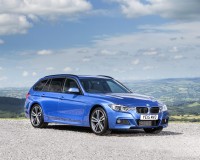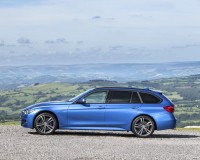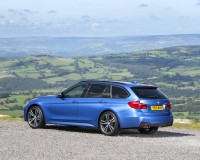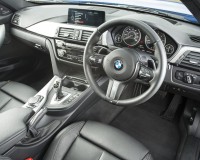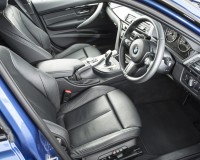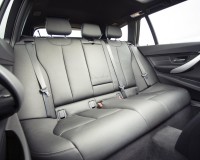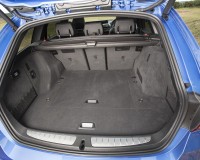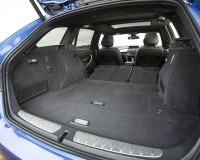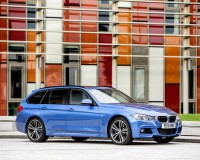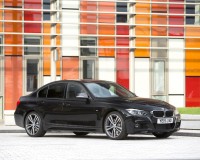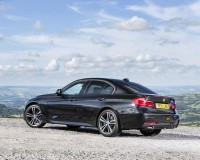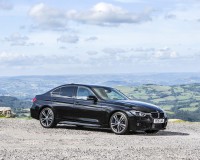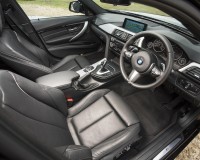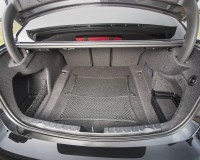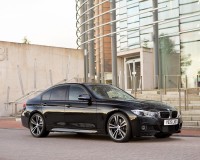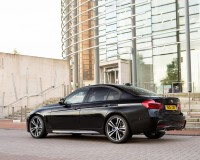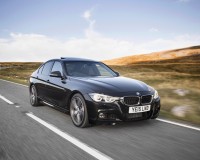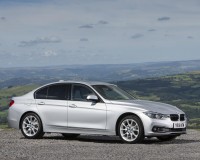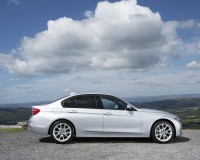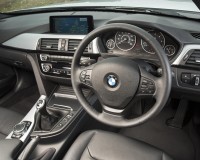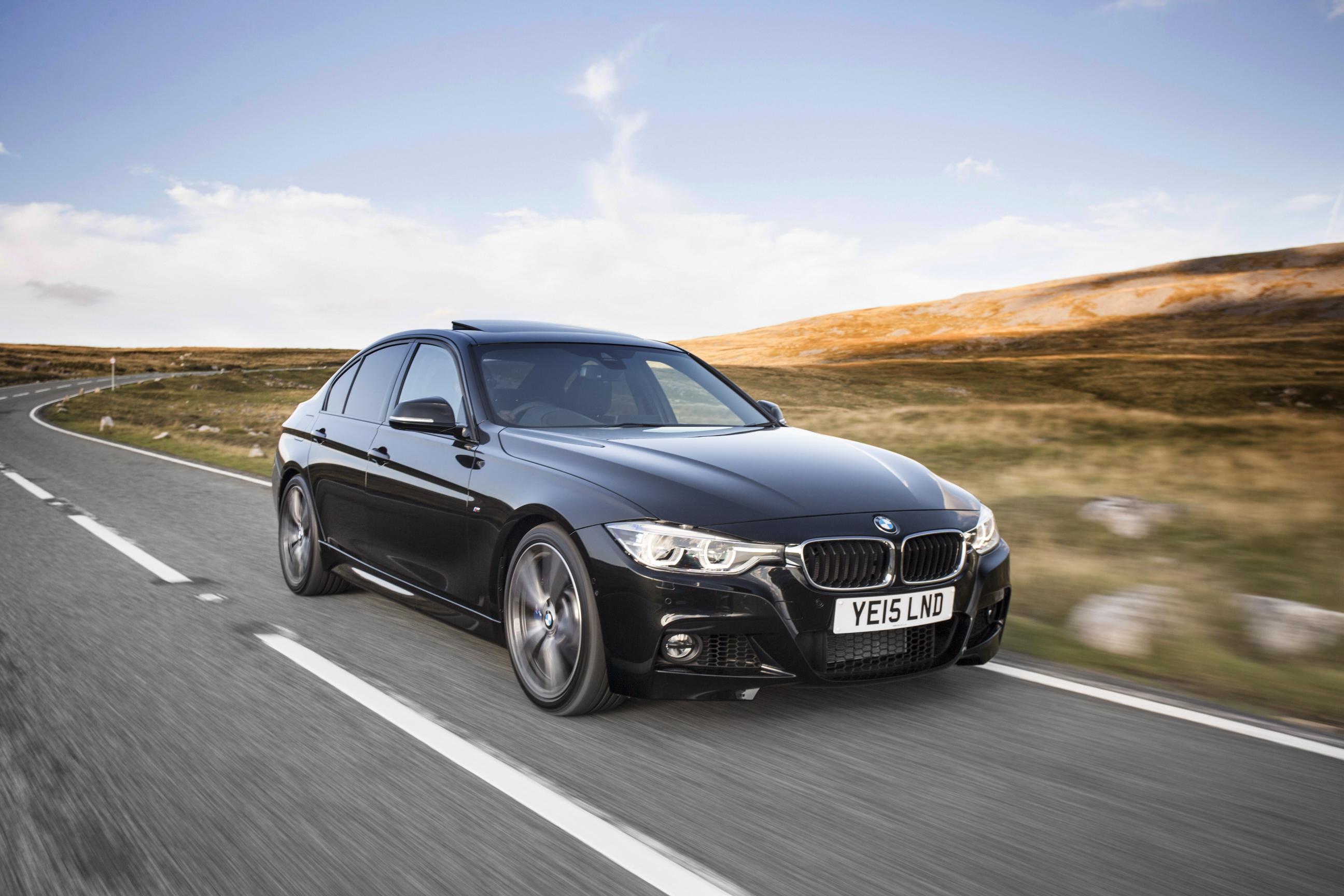
Introduction
When an industry segment is named after one car, the domination of that car is evident. Over the past 40 years, ‘the 3 Series segment’, as it has become known, clearly defines the dimensions and performance of the smaller executive car class. The model range was launched 40 years ago to replace the already legendary BMW 02, and has now just had an extensive update as part of the planned life cycle of what is now the sixth generation. Today, as in 1975, purchasing a BMW 3 Series represents an expression of joy in sporty, agile handling, enthusiasm for innovative technology and appreciation of premium quality.
First unveiled at the 1975 International Motor Show (IAA) in Frankfurt, the BMW 3 Series has since developed into both the brand’s most successful model range and an international bestseller. And that makes the 3 Series a highly effective global ambassador for BMW’s core attributes. Its history is testament to the advances achieved by the German carmaker in the areas of sporting ability, efficiency, safety, comfort and connectivity, as well as to the development of BMW design. Again and again, the introduction of trailblazing technological innovations in the BMW 3 Series has also broken new ground in the mid-size class in general. Moreover, for four decades now the BMW 3 Series has led the way with new vehicle concepts that have expanded the brand’s model line-up and injected fresh ideas into the segment as a whole.
The underlying character of the BMW 3 Series endures from generation to generation, complemented by the addition of new technological advances. Its design has likewise been shaped by a characteristic BMW sense of continuity and evolution. Indeed, throughout the model range’s history, its striking front end with twin circular headlights and familiar BMW kidney grille, the dynamic lines of the car’s flanks and the powerful rear end have always been quick to catch the eye. As for the interior, the unmistakable driver-focused cockpit design already established itself as a key element in the first model generation. The 3 Series’ exceptional run of victories in race competition has also contributed to the car’s status as a byword for sports performance. From the success notched up by the original BMW M3 which came in the second generation, E30 series, its enviable record has continued all the way to victory in the German Touring Car Masters (DTM) race series in 2014.
The first generation of the mid-size sedan delighted customers with a level of sporty handling never before offered in this segment, while also impressing with its super-economical engines. Thanks to the performance and sporty, commanding character of those engines, the transfer of power to the rear wheels and the efficiency with which the resultant driving pleasure is conjured up, the BMW 3 Series continues to rise above its rivals to this day.
In 1977, two years after the launch of the new model range, the BMW 3 Series became the first car in its class to be available with six-cylinder engines. Further innovations were to follow, including revolutionary injection and engine management systems, ultra-sporty diesel engines and weight minimisation through the use of aluminium and magnesium.
Today, the new generation of BMW Group engines in the BMW 3 Series lies at the heart of BMW Efficient Dynamics. The continued improvement in engine performance and driving attributes, coupled with reductions in fuel consumption and emissions, has been a decisive factor in securing the pioneering status of the BMW 3 Series.
Powerful engines and the transfer of power to the rear wheels have been combined with finely balanced weight distribution and advanced chassis construction from day one of the BMW 3 Series. Back in 1975, drivers of a BMW 3 Series were already guaranteed handling that was sportier than any of its rivals and assured in any situation, thanks to technically sophisticated suspension, extremely precise steering uncorrupted by torque steer and powerful brakes. It is a standard that has been maintained through to the new generation of the car. Each and every component of the chassis may have undergone an impressive process of development over the course of four decades and six generations, but the basic concept underpinning Sheer Driving Pleasure endures. Boasting the most advanced chassis in its segment, the BMW 3 Series continues to set the benchmark for sports performance and handling agility.
The BMW 3 Series’ ascent to the top of the tree in terms of agility and safety has also been aided by another innovation. In 1985 the BMW 3 Series became the brand’s first series-produced car to channel its power to the road through all four wheels. And today the BMW 3 Series is the only model range in which the BMW xDrive intelligent all-wheel-drive system can be combined with seven different engine variants.
Growth and changes within the model line-up have since been responsible for a succession of landmarks in the history of the BMW 3 Series, introducing innovative concepts which continue to set trends for the segment as a whole to this day. The diversity of models has played a significant role in enabling a variety of target groups to experience the sporting character of BMW 3 Series in different ways. The sixth model generation further extended this attractive selection of distinctive body variants during the earlier stages of its launch, which are now split between two model ranges: the BMW 3 Series Sedan and BMW 3 Series Touring have been joined by the BMW 3 Series Gran Turismo, and the mid-size model portfolio now also includes the BMW 4 Series Coupe, BMW 4 Series Convertible and BMW 4 Series Gran Coupé.
BMW 3/15 PS DA 2 – two-seater openBMW 02 Series
Although BMW has produced compact-sized cars since the 3/15 Dixi of 1928, the bloodline of the 3 Series can be traced back to 1966, with the launch of the BMW 1600-2. BMW was buoyed by the success of the larger BMW 1500 in 1961 (the model that secured BMW’s path to success after near bankruptcy in 1959) and the later 1600, 1800 and 2000 four-door saloons. Moving on 11 years and these models had grown into the mid-sized executive level 5 Series. With this development, BMW engineers had the opportunity of designing a new ‘small’ BMW. The result was the BMW 1600-2.
The BMW 1600-2 (the last digit denoting two doors) was a revelation at its launch in 1966. Its sleek body offered ample space for four adults yet its 85bhp four-cylinder engine delivered a top speed of just over 100mph and zero to 62mph acceleration in 13 seconds. Gone were the days when drivers had to buy an uninvolving car to carry out the familial duties. At last a car was available which combined the response and excitement of a sports car with practicality too.
The 02 Series was built from May 1966 until July 1976 with 861,940 units leaving the Munich plant’s production lines. The model variants ranged from the 1600-2 through the 90bhp 1802, 100bhp 2002, 105bhp in the 1602ti, 120bhp in 2002ti and 130bhp in 2002tii all the way to 170bhp in the 2002 turbo. Incidentally, the 2002 turbo was the first European production turbocharged car and bore the now politically incorrect reversed ‘turbo’ decals on its front spoiler. In addition, there were model variations such as the Touring (not an estate car as Touring models are today but one of the first hatchbacks), a Convertible and a Targa all built in relatively small production runs.
The 2002, in particular, etched its place as a classic both on road and track. A very strong owners club following confirms the 02’s durable popularity whilst drivers of the calibre of Hans Stuck and Dieter Quester cut their competitive teeth on even more modified 2002’s.

E21 – The first generation
Although the BMW 02 models were the predecessors of the 3 Series, the first model carrying the 3 Series moniker was launched to the worldwide press at the Olympic Stadium in Munich in July 1975. Using the engineering number E21, the ‘new’ two-door saloon BMW 3 Series measured 4,355mm in length, 1,610mm wide and 1,380mm tall. With its long wheelbase of 2,563mm and consequent short overhangs, the first 3 Series shared its overall proportions with all subsequent generations. The all-four cylinder range started with the 316 that delivered 98bhp but weighed only 1,010kgs and consequently ensured a spirited driving performance from the entry model. The range also included the 318, 320 and the halo model 320i. With its 125bhp, the 320i offered near-sports car performance with a top speed of 112mph, aided by an independent spring strut suspension at the front and rear to deliver a truly revolutionary sporting drive.
The design of the body followed the new approach already applied to the BMW 5 Series by head designer Paul Bracq and was distinguished by a clear use of forms. The front end was dominated by the striking BMW kidney grille and circular lights, the latter featured in twin-headlight form in the top-of-the-line models with 2.0-litre engine. Other distinctive elements included the coupe-like side window graphic including the Hofmeister kink at its trailing edge and the “power dome” contouring of the bonnet.
The interior of the BMW 3 Series witnessed the debut of the now familiar driver-focused cockpit design. The vertically stacked controls in the centre of the dashboard were angled clearly towards the driver, making them easier to reach and read. This new development helped to optimise ergonomics and remains a signature feature of BMW models to this day.
The official presentation of the BMW 3 Series – on the day before the opening of the 1975 International Motor Show (IAA) in Frankfurt – saw the Chairman of the BMW AG Board of Management draw particular attention to the BMW 320i. “In our eyes this car is the worthy modern successor to the fabled BMW 2002 tii,” noted Eberhard von Kuenheim. With a helping hand from fuel injection technology, the four-cylinder engine under the bonnet of the BMW 320i produced 125hp. And that was enough to propel it not only to the top of the 3 Series range but also into the highest reaches of car fans’ affections. In the year following its debut, readers of Europe’s biggest-selling motoring magazine voted the flagship 3 Series model “the world’s best sedan” in the class up to two litres displacement.
The model range also included the BMW 316, BMW 318 and BMW 320 variants from launch. Their model designations were derived from the size of their engine displacement: 1,573cc, 1,766cc and 1,990cc respectively. The sophisticated four-cylinder carburettor engines combined sporting performance characteristics with very reasonable fuel economy. Even the 90hp entry-level engine in the BMW 316, which weighed just 1,010 kg, allowed customers to experience a top speed of 99mph.
The engine line-up blossomed in spectacular style in 1977, as the lower mid-range welcomed the arrival of six-cylinder engines for the first time. The 2.0-litre engine for the BMW 320 and 2.3-litre unit bestowed on the BMW 323i were designed especially for the BMW 3 Series. The straight-six powering the BMW 323i included features such as electronically controlled engine management and transistor ignition, generated 105 kW/143hp and accelerated the two-door car from 0 to 62 in just 9.0 seconds.
The engine’s task of fast-tracking the 3 Series to sporting eminence in the mid-size segment was shared by independent suspension featuring control arms and spring struts at the front axle and semi-trailing arms/spring struts at the rear. The front axle control arms had a MacPherson construction using anti-roll bars, creating the perfect platform for excellent steering precision. The 3 Series also gave an all-new design feature its BMW premiere: elastically mounted rack-and-pinion steering. The first-generation car had earned itself a reputation for outstanding driving dynamics and agility that remains resoundingly intact in the latest model to wear the 3 Series badge.
Successful changing of the guard: the BMW 3 Series becomes the new bestselling model in the company’s history.
The BMW 315, powered by a 1.6-litre engine developing 75hp, joined the fray in 1981 as the new entry-level model in the line-up. The same year, BMW 3 Series sales reached the one-million mark. That meant the new model range had outstripped the figure recorded by its predecessor after just six years in production to become the most successful model in the company’s history. Customer satisfaction levels were also exceptionally high. In a survey conducted in 1980, 80 per cent of BMW 3 Series drivers said there was “nothing they could improve” about their car.
A total of 1,364,039 units of the BMW 3 Series were sold up to 1983, of which 4,595 were in “Topcabriolet” trim. This take on the 3 Series recipe was the work of Stuttgart-based coachbuilder Baur, whom customers could commission to conjure any engine variant of the 3 Series into an open-top four-seater with a suitably burly rollover bar.
This innovative combination of handling and performance in a compact car had clearly struck a cord with buyers. This is highlighted by a customer survey from 1980 suggesting that 77 per cent of purchasers brought the 3 Series because of its superior performance, 65 per cent because of its handling and 64 per cent due to the looks of the car. With this success, after only one year of production, sales of the new 3 Series has outperformed the aspirations of even the most optimistic planners, prompting the then Chairman of the Board of BMW Management, Eberhard von Kuenheim to suggest a “level of success far beyond our own expectations”.
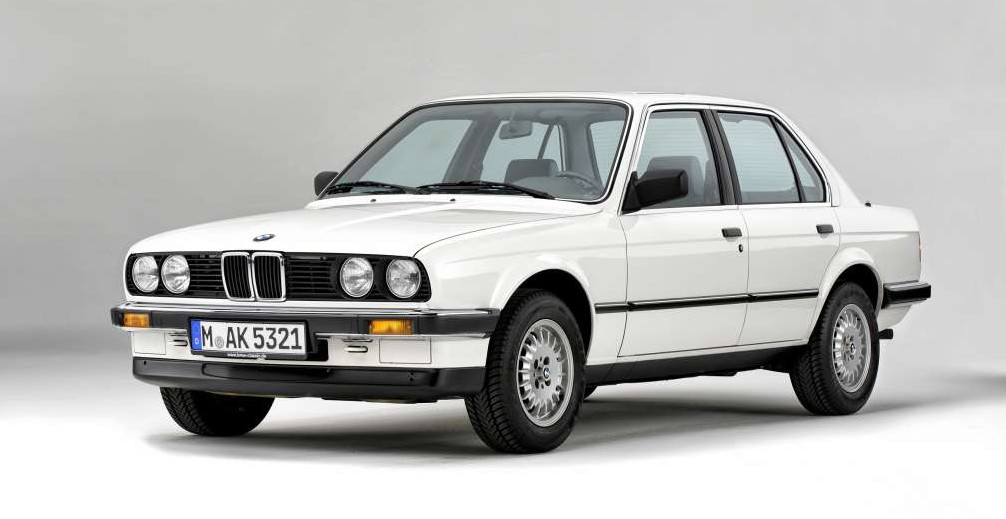
E30 – the second generation
The next generation 3 Series, the E30, made its introduction in 1982. Having been thoroughly revised and updated, the slightly larger second-generation car offered four centimetres more interior space inside and a 35mm wider track, whilst being an average of 30kg lighter than its predecessor.
In autumn 1983, after one year and 233,781 units of two-door saloon production, a four-door 3 Series model was launched for the first time and in its eight-year life, the E30 3 Series also became a full Convertible (the E21 3 Series offered only a Baur Cabriolet conversion) and a Touring – this time as a convenient small estate variant.
The new car’s lines were significantly tauter and smoother than those of its predecessor, and its drag coefficient had been reduced by almost 15 percent. All model variants, regardless of engine size, were now fitted with twin circular headlights as standard. Although the second-generation 3 Series offered four centimetres of extra legroom inside, its body was actually three centimetres shorter than the previous model. The front indicator lights were relocated from the wing tip into the bumper. The characteristic side view was given a fresh interpretation, while a broader B-pillar painted matt black provided a stronger-looking centre. The 35mm-wider track, meanwhile, gave the new car a muscular appearance. To top it all, the BMW development engineers had shaved around 30 kg off the car’s weight – despite its more generous equipment levels.
Advanced engine technology makes the BMW 3 Series a sportier and more efficient proposition.
The new BMW 3 Series lined up with further developed four- and six-cylinder engines. For example, the BMW 316 – which produced 90hp and now had an electronically controlled carburettor – boasted a top speed of 109mph. Developing 105hp from its four-cylinder engine with mechanical injection, the BMW 318i powered to a maximum 114mph.
The six-cylinder models already featured an electronic injection system. The 139hp BMW 323i, for example, recorded a top speed of 126mph, its five-speed gearbox with overdrive allowing it to post average fuel consumption of just 31.7mpg.
A new engine concept designed squarely with torque and economy improvements in mind was introduced in 1984, pushing efficiency to even greater heights. The six-cylinder in-line eta engine developed 122hp from its 2.7-litre displacement and enabled average fuel consumption of 33.6mpg in the BMW 325e. This was also the first BMW 3 Series model to be available exclusively with a catalytic converter. In the 1980s the BMW 3 Series featured the widest selection of variants fitted with a catalytic converter in its segment. Another new development was introduced into series production in the BMW 325e and, a year later, the BMW 325i with six-cylinder 171hp engine; digital engine electronics optimised fuel injection and mixture preparation.
Another engine variant presented at virtually the same time as the BMW 325i majored on economical driving. This was the first time BMW had fitted a diesel engine in its compact Sedan. The BMW 324d featured a six-cylinder in-line unit developing 86hp and hit a top speed of 103mph. It recorded average fuel consumption of 40.9mpg.
In 1987 the original diesel variant was joined by the BMW 324td. Its new straight-six turbo diesel engine impressed with output raised to 115hp, lower fuel consumption and emissions, and lower levels of noise and vibrations. The key factor in this leap forward, along with the use of a turbocharger, were Digital Diesel Electronics (DDE). This technology brought more sophisticated injection – adjusted to the situation at hand – to diesel engines as well.
Advanced engine technology makes the BMW 3 Series a sportier and more efficient proposition.
The new BMW 3 Series lined up with further developed four- and six-cylinder engines. For example, the BMW 316 – which produced 90hp and now had an electronically controlled carburettor – boasted a top speed of 109mph. Developing 105hp from its four-cylinder engine with mechanical injection, the BMW 318i powered to a maximum 114mph.
The six-cylinder models already featured an electronic injection system. The 139hp BMW 323i, for example, recorded a top speed of 126mph, its five-speed gearbox with overdrive allowing it to post average fuel consumption of just 31.7mpg.
A new engine concept designed squarely with torque and economy improvements in mind was introduced in 1984, pushing efficiency to even greater heights. The six-cylinder in-line eta engine developed 122hp from its 2.7-litre displacement and enabled average fuel consumption of 33.6mpg in the BMW 325e. This was also the first BMW 3 Series model to be available exclusively with a catalytic converter. In the 1980s the BMW 3 Series featured the widest selection of variants fitted with a catalytic converter in its segment. Another new development was introduced into series production in the BMW 325e and, a year later, the BMW 325i with six-cylinder 171hp engine; digital engine electronics optimised fuel injection and mixture preparation.
Another engine variant presented at virtually the same time as the BMW 325i majored on economical driving. This was the first time BMW had fitted a diesel engine in its compact Sedan. The BMW 324d featured a six-cylinder in-line unit developing 86hp and hit a top speed of 103mph. It recorded average fuel consumption of 40.9mpg.
In 1987 the original diesel variant was joined by the BMW 324td. Its new straight-six turbo diesel engine impressed with output raised to 115hp, lower fuel consumption and emissions, and lower levels of noise and vibrations. The key factor in this leap forward, along with the use of a turbocharger, were Digital Diesel Electronics (DDE). This technology brought more sophisticated injection – adjusted to the situation at hand – to diesel engines as well.
By the end of its first year in production, over 230,000 units of the second-generation BMW 3 Series had been sold – and the introduction of a second body variant was about to increase demand even further. The first BMW 3 Series with four doors was unveiled in autumn 1983 and offered principally functional benefits, notably more comfortable access to the rear compartment. The desire for open-air driving pleasure was likewise soon to be fulfilled. The BMW 3 Series Convertible presented in 1985 earned itself an instant fan club with its elegant silhouette, low and horizontal shoulder line and a seating position which made interaction with the outside world a particularly intense experience.
The development engineers’ well of creativity was still far from dry. For example, the BMW 3 Series Touring revealed in 1987 represented a whole new way of combining driving pleasure and functionality. Sporty, agile and visually appealing, the first BMW 3 Series with a generously-sized rear compartment offered something different from the existing norm in this breed of car. And that set it apart as something of a trendsetter. The variety of BMW 3 Series models now available to customers played a major role in ensuring the second-generation car notched up 2,339,251 units in sales, outperforming its predecessor by almost a million cars in the process.
The history of this generation of the 3 Series also spans a raft of special editions and a pioneering role in the field of electric mobility. In 1987 eight BMW 325iX models were converted to electric front-wheel drive. The battery that would provide the requisite energy could be charged from a conventional power supply. This variant of the BMW 3 Series was the brand’s first electric car to complete a practical trial under everyday conditions.
As with all BMW’s, this 3 Series generation was only offered in the UK as a rear-wheel-drive car, but on the continent, a four-wheel-drive 325ix was available. The E30’s hugely successful production run ended after 2,220,225 units had been built.
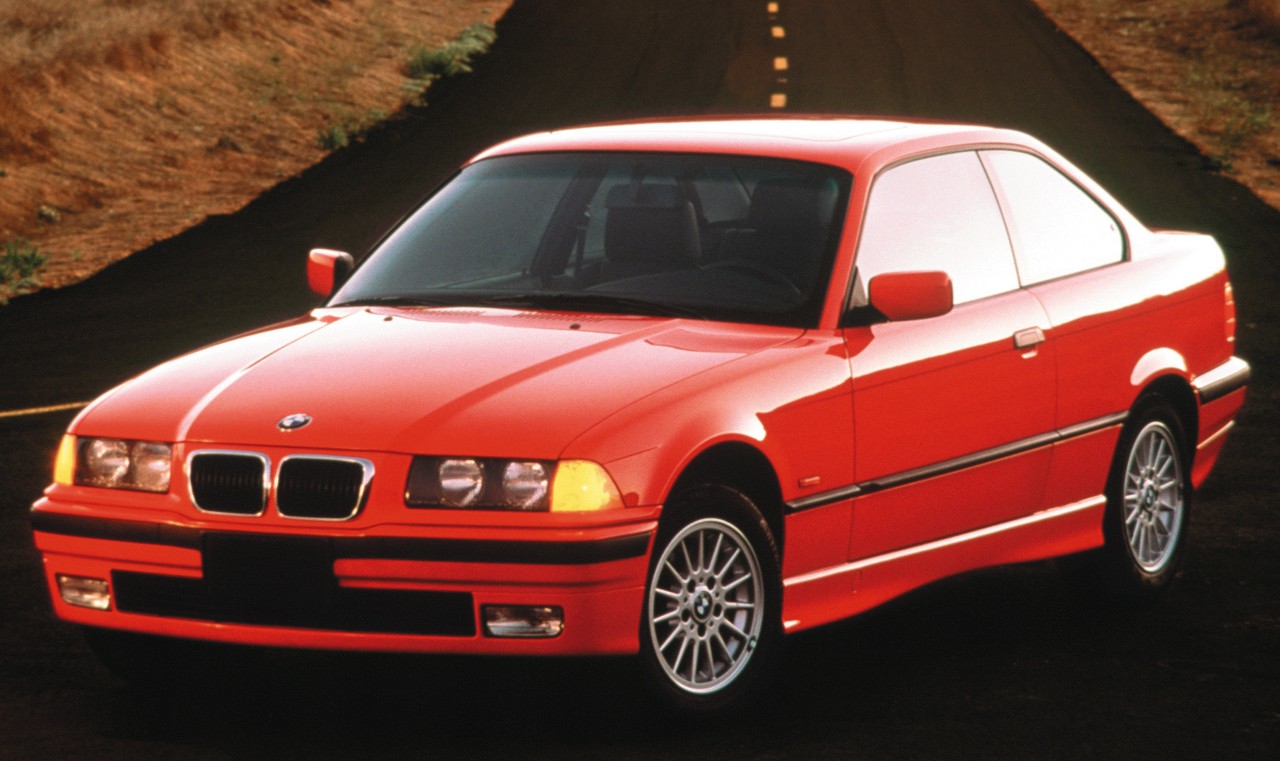
E36 – the third generation
Launched at Miramas in the South of France, the third generation 3 Series range, codenamed E36, was offered for the first time as a four-door saloon at launch in 1990, reflecting the growing popularity of four door variants in the E30 range. The body had grown significantly in terms of exterior dimensions to create an even more comfortable and safer passenger compartment, and it offered occupants noticeably more space. Those in the rear, for example, could look forward to 30mm of extra knee room. Despite its increase in size, the car’s basic form also displayed an undeniably sporty edge. The long wheelbase, short overhangs, 1,418mm front track and 1,431mm rear track gave a strong hint of the new 3 Series’ outstanding driving attributes.
Also instantly catching the eye alongside the new car’s slender silhouette was its smooth front end, with each set of twin circular headlight units positioned behind a single glass cover. One of the benefits of this front-end construction, which remains the norm today, is optimised pedestrian protection. Safety was a big priority overall, and all variants of the new BMW 3 Series included new door strengthening elements for improved side impact protection.
The initial saloon version was followed in 1992 by a new model variant: the former two door was now renamed Coupé for the first time to reflect its subtle, yet extensive, design differences. The 3 Series Coupé was followed by the Convertible, Touring and, a new model, the Compact.
The engines available from launch all developed at least 100hp. The entry-level 1.6-litre unit in the new BMW 316i, for example, produced 100hp while the BMW 318i had 113hp. The two innovative six-cylinder in-line engines in the line-up both now featured twin camshafts and four valves per cylinder. The BMW 320i developed 150hp and the BMW 325i was good for 192hp. Innovative technology designed to boost performance and reduce fuel consumption also came in the form of VANOS variable camshaft timing. It was first introduced in 1992 in the 286hp six-cylinder engine powering the second-generation BMW M3 and subsequently made the jump into the other six-cylinder models.
The inevitable rise of the sporty diesel engine continued with the arrival of the 2.5-litre, 115hp unit in the BMW 325td. And more was to come in 1993, a new turbocharged six-cylinder diesel engine with charge air cooling putting 143hp and peak torque of 260Nm at the disposal of the BMW 325tds. It powered the new Sedan from zero to 62mph in 10.4 seconds, but had average fuel consumption of just 42.2mpg. A year later, the BMW 318tds was added to the range as the new entry-level diesel model. Its four-cylinder turbodiesel unit with charge air cooling and 90hp boasted impressive average fuel economy of just 47.9mpg.
The new generation of six-cylinder in-line petrol engines which followed in 1995 were significantly lighter than those they replaced, thanks to their aluminium crankcase. They were also more powerful and more efficient. The displacement of the flagship engine increased from 2.5 to2.8 litres, and the new range-topping model was given the BMW 328i badge. Stirring under the bonnet was output of 193hp and peak torque of 280Nm.
The third generation of the BMW 3 Series employed a single-joint strut suspension with anti-roll bars at the front axle. At the rear, meanwhile, a new central control arm with two lateral control arms, one above the other, now ensured optimised directional stability (especially under high cornering speeds), harmonious roll characteristics and increased suspension comfort. Both the front and rear axle featured twin-tube gas-filled shock absorbers. And for the first time, the engineers had made the car’s track wider at the rear than at the front. This arrangement remained a fixture of the 3 Series’ design in the model generations that followed.
Power assistance for the latest development of BMW’s rack-and-pinion steering system now came as standard in the BMW 318i, and the effectiveness of the brakes was also enhanced once again. The Anti-lock Braking System (ABS) was included as standard on all variants from 1992, and Automatic Stability Control (ASC) was now also offered as an option. The anti-slip control system, meanwhile, capped the generation of engine power to levels that could be transferred to the driven wheels before they threatened to start spinning – regardless of how heavily the driver was pressing the accelerator. From 1997 this technology was offered in extended form – as ASC+T – with additional brake intervention to stabilise the car.
The third generation of the BMW 3 Series was also offered with a selection of body variants developed to appeal to additional customer groups. However, the launch order adopted by its predecessor was reversed. The four-door became the default variant for this segment, and the two-door – introduced at the start of 1992 – was no longer a sedan, but an extremely elegant coupe. Although the similarity between the two- and four-door variants was clear, the two variants only shared a handful of parts. The first BMW 3 Series Coupé was a resolutely standalone car.
It was also the model on which the BMW M3 was based, it rode three centimetres closer to the road surface and cut an imposing figure with its suitably sporty front end. The classically elegant flank line was the product of an eight-centimetre-longer front end, lower bonnet, almost three-centimetre-shorter roof, wider doors with frameless windows, and a shorter and lower boot lid.
The BMW 3 Series Convertible was the next variant to hit the road in 1993. The open-top 3 Series once again featured a distinctively low shoulder line. It offered space for four people and unbeatable all-year weather protection courtesy of an outstandingly well-insulated soft-top roof. A hardtop could also be fitted as an option.
It wasn’t long before BMW was unveiling another concept innovation. Launched in 1994, this new body variant offered a sporting character wrapped in particularly compact packaging. It was a combination reflected in its name: the BMW 3 Series Compact measured a mere 4.21m in length, had two doors and a steeply rising rear end (including a large boot lid) and offered space for four to five people.
In 1995 BMW presented the new edition of another mould-creating car. The new BMW 3 Series Touring now showcased the dynamic qualities of the 3 Series range and practical virtues of its body concept even more convincingly. The new five-door model came with largely the same equipment levels as the Sedan, combined with the exclusive upholstery options and interior colours available for the Coupé. Versatility with style was what the BMW 3 Series Touring was all about.
With its range of no less than 31 different models, this 3 Series range, comprising Saloon, Coupé, Convertible, Touring and Compact models reached a grand total of 2,745,773 – 69,794 of which were M3 variants.

E46 – The fourth generation
1998 saw the introduction of the new most recent 3 Series, codenamed E46. Initially only available as a Saloon, the E46 followed the pattern set by its predecessor in additionally offering Coupé, Convertible, Touring and Compact variants. The Saloon version again grew in size by four centimetres and, when compared to the original 3 Series of 1975, was 12cm longer. Rear seat passengers also enjoyed a further 10mm of legroom over the outgoing E36 model.
The selection of available body variants expanded more quickly than in the previous model generation. The new BMW 3 Series Coupe, which was 17mm longer, 18mm wider and 46mm lower to the road than its four-door sibling, took to the stage as early as April 1999. It also offered occupants significantly more space than its predecessor. The combination of the car’s distinctive proportions and a shallower windscreen angle produced a noticeably stretched, elegantly slender side view.
The third variant of the BMW 3 Series – the Touring – joined the line-up later that year, the BMW development engineers continuing to drive forward the idea of the dynamic, elegant and classy five-door car. The new Touring embodied the character of the 3 Series with undoubted clarity, but also displayed its own distinctive talents. It was 46mm longer than its predecessor, 16mm wider and 29mm taller.
A Convertible variant was also developed for the fourth generation of the BMW 3 Series model range. The open-top four-seater made its debut in spring 2000. It was identical to the Coupé from front bumper to A-pillar, but the prominent beltline and muscular rear end gave it a character very much its own. On the inside, the Convertible was the first model in this class to feature front seats with integral seat belts as standard. Standard rollover protection, consisting of a rollover bar in the windscreen frame and two bars which extended automatically from the rear head restraints as required, maximised occupant protection even in extreme situations
The new BMW M3 also celebrated its world premiere that year at the Geneva Motor Show. The contouring of its bonnet alone provided an indication of the power lurking beneath. The eye-catching bulge in the centre of the bonnet – the so-called “power dome” – created space for the new six-cylinder in-line engine with displacement of precisely 3,246cc and output of 252 kW/343hp. In spring 2001 the line-up was expanded further to include the open-top variant of the high-performance sports car – the BMW M3 Convertible.
Early 2001 saw the arrival of a replacement for the BMW 3 Series Compact.A new interpretation of the signature BMW twin headlights gave the BMW 3 Series Compact a highly recognisable front end. It was also 53 mm longer and wider than its predecessor. All this extra space was used to enhance passenger comfort. The E46 generation marked the first time that diesel-engined 3 Series cars were brought by UK customers in large numbers. In the previously generation E36, the 325td and 325tds models were offered with limited success. The E46 320d changed that, delivering 136bhp and a top speed of 128mph. However, with the obvious benefits of diesel engines, the car delivered 49.6mpg on the combined cycle. Although UK customers were, at the time, relatively slow to appreciate the benefits of diesel technology, word soon spread and in 2003, the 320d overtook the 318i as the UK’s single largest selling model in the BMW range. The larger diesel-engined 330d was launched in 2000 in Touring guise, delivering 184bhp but more importantly 390Nm of torque. Achieving a top speed of 140mph yet still delivering 40.3mpg, this represented the first opportunity UK drivers had of buying a diesel-engined sports car – something that would have been considered unthinkable only a few years prior. As a further demonstration of diesel engines pushing back the boundaries of what was deemed acceptable, the 2.0-litre and 3.0-litre diesel engines subsequently made their way into Coupé and Convertible variants.
The final piece of the 3 Series jigsaw was the E46 3 Series Compact. Launched in 2001, the smaller dimensions of the car (same wheelbase as other E46 models but 21cm shorter) and the large-opening hatchback boot lid appealed to those who wanted a ‘compact’ car but needed to retain 3 Series levels of practicality. But the 3 Series Compact also marked a landmark for the BMW Group in the UK. The 1.6-litre and 1.8-litre four-cylinder engines in the Compact featured VALVETRONIC variable valve lift technology for the first time, and were built at BMW’s manufacturing plant at Hams Hall, Warwickshire.
The new six-cylinder diesel engine with 3.0-litre displacement made its BMW 3 Series debut the same year. This powerful unit performed impressively under the bonnet of the BMW 330d thanks to output of 184hp and peak torque of 290Nm. Featuring four-valve technology, direct injection, a turbocharger with variable turbine geometry and charge air cooling, its design principle largely mirrored that of the four-cylinder unit in the BMW 320d. There was, however, one key difference: a common-rail injection system took over fuel supply duties from the distributor-type fuel injection pump previously employed. BMW was therefore an early adopter of technology which remains the favoured option today in terms of both power delivery and smooth running.
The sporting yet extraordinarily refined character of BMW’s diesel engines transformed the standing of this form of propulsion – and soon led to all-new applications. For example, in 2002 BMW unveiled its first diesel-engined Coupe, the BMW 330Cd. A short time later it was time for the first open-top diesel model to grace the BMW ranks. The BMW 320Cd Convertible led the way in 2004, but didn’t have to wait long for the six-cylinder BMW 330Cd Convertible to join it in the line-up. Back in 2001, BMW engine experts provided further evidence of their talent for innovation by developing technology aimed at enhancing driving dynamics while at the same time optimising fuel economy. Their new VALVETRONIC – fully variable intake valve timing – system for petrol engines was available exclusively for BMW vehicles, and the BMW 316ti Compact was the world’s first series-produced vehicle to be fitted with a 1.8-litre engine which worked using this technology. The four-cylinder unit produced 115hp.
BMW had developed VALVETRONIC as an alternative to the first generation of petrol direct injection systems, whose potential for fuel savings could not be exploited to sufficient effect in day-to-day driving. Also described as a throttle-free load control system, VALVETRONIC enabled a reduction in fuel consumption of up to ten per cent, regardless of fuel quality.
BMW developed a new lightweight chassis and innovative driving stability systems for the fourth generation of the BMW 3 Series model range. Its basic construction and a raft of technical highlights elevated the chassis to a level previously only explored by some luxury cars. Aluminium now accounted for around 20 per cent of the chassis’ weight, while the targeted use of high-strength steel in the front and rear axle carriers shaved off a few more kilos.
The ASC+T traction control system was included in the standard specification of the BMW 3 Series once again. A new addition, meanwhile, was Dynamic Stability Control (DSC), which intervened as required to counteract understeer or understeer through dynamically taken corners. Initially available as an option for the BMW 328i, in 2001 it became a standard feature of all BMW 3 Series models.
From 2000 both the Saloon and Touring versions of the BMW 3 Series were offered with the new version of BMW’s all-wheel-drive system. This permanent transfer of power to all four wheels was now linked up with the Dynamic Stability Control system.
By the end of 1999 the success of the fourth-generation BMW 3 Series could also be found on record in the statistical data compiled by the Federal Motor Vehicle Office in Flensburg, Germany. The BMW 3 Series ended the year in third place in Germany’s registration statistics – a level of success never before achieved by a representative of this market segment. By the time production of the fourth model generation had come to an end, total sales had climbed to a historical peak for the BMW 3 Series of 3,266,885 units.
From the start of production in 1998 until February 2005, a total of 3,141,330 E46 3 Series models had been built.
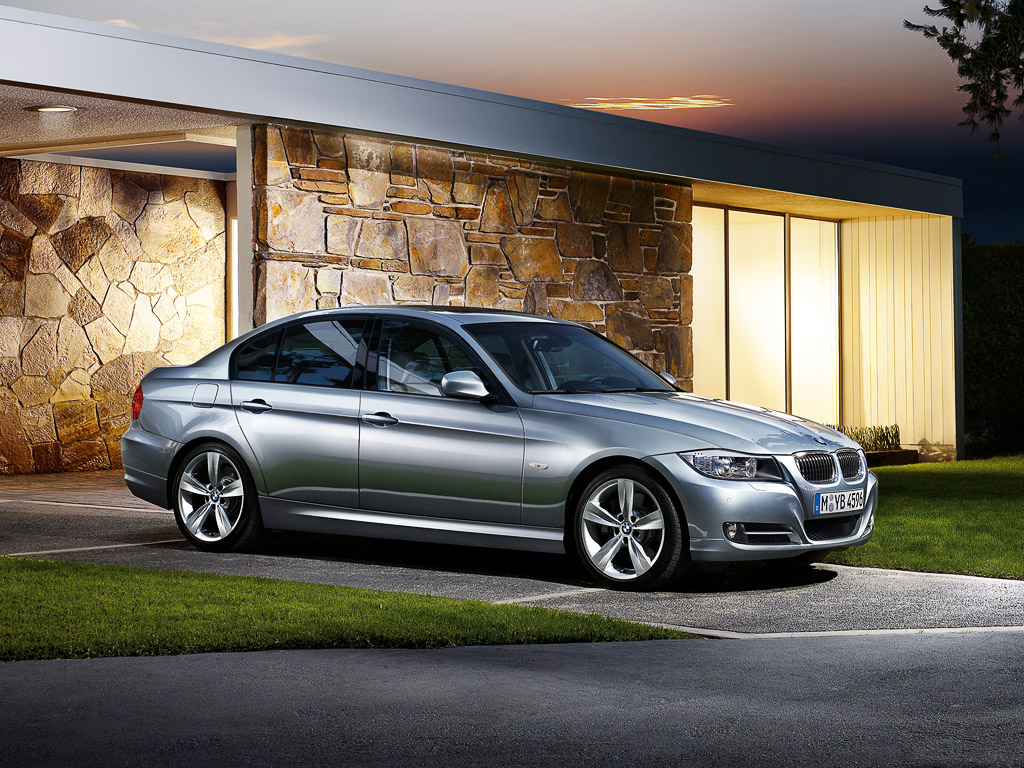
E90 – 30 years after its introduction, the fifth generation of 3 Series
The fifth generation of the BMW 3 Series celebrated its world premiere at the 2005 Geneva International Motor Show. In what was now the regular running order for model range launches, the four-door Saloon was the first model variant to be introduced. Its striking appearance, with short body overhangs, dynamic lines and a progressive design language, imbued it with an unmistakable character from day one. The new symbiosis of powerful and efficient engines, dynamic yet refined driving characteristics, eye-catching design (with the familiar BMW use of forms), a spacious body with impressive torsional rigidity and innovative equipment features met with enthusiastic approval around the world. In its first year post-launch, the new BMW 3 Series was awarded the title “World Car of the Year” in New York.
The far more imposing and powerful aura of the new BMW 3 Series Saloon compared to its predecessor was the result of a more striking design and larger dimensions. Indeed, the new car added 49mm in length, 78mm in width and 10mm in height. This all-round growth was used to the benefit of occupant comfort and safety. However, intelligent lightweight design meant that, despite the car’s extra size and equipment, it was no heavier on the scales.
All the variants of the fifth-generation BMW 3 Series offered an unsurpassed combination of space, comfort, safety, dynamics and efficiency – regardless of their body type. The new BMW 3 Series Touring stood apart from its predecessor and surged to the top of its segment on the back of significant increases in many areas (aside from weight), as well as featuring an upper-case initial in its model designation for the first time. The five-door variant, also presented during the course of 2005, was 42mm longer, 78mm wider and 9mm taller than its predecessor. Occupant comfort and load capacity were among the winners here, and the car’s driving characteristics were also enhanced, as the 35mm longer wheelbase helped to reduce vehicle vibrations.
The BMW 3 Series Coupé (E92) introduced in 2006 was also more distinctive than ever. Its standalone character was marked out instantly by the stretched, sporty lines of a body which had been newly designed down to individual details. The new BMW 3 Series Coupé also offered more interior space than its predecessor. The Coupé was the first ever BMW model to offer a twin-turbocharged engine and High Precision Direct Injection technology. Launched initially with 306hp 335i and the 218hp 325i engines other derivatives soon followed including the 320d which was destined to be the biggest selling model.
Later in that same year the Convertible (E93) came to market with its own industry firsts. The 325i Convertible and 335i Convertible were the first ever BMW open-top cars to feature an electronically controlled retractable hard-top roof and the first convertible in the world with the option of a through-load luggage storage option. The new Convertible also had a world first with Sun-Reflective leather upholstery that allowed the surface of the seats and other areas to remain at a constant temperature despite harsh direct sunlight.
The new BMW M3 was also presented in 2007. The high-performance sports car, based on the BMW 3 Series Coupé, boasted a distinctive design exuding high-level athleticism and was powered by a newly developed V8 engine with 420hp. It was a combination that secured the latest M3 a stand-out position in the exclusive ranks of top-class premium sports cars. The introduction of a selection of other body variants in Spring 2008 provided even greater scope for individuality. A trio of distinctive characters were now ready for action – the BMW M3 Coupé, BMW M3 Convertible and BMW M3 Saloon.
The range of engines developed for the fifth generation of the BMW 3 Series included a wealth of innovations focused on enhancing driving pleasure and efficiency in equal measure. The four-cylinder diesel engine powering the BMW 320d used second-generation common-rail injection and a turbocharger with variable turbine geometry to deliver output of 163hp and peak torque of 340Nm.The two six-cylinder petrol engines, like the 150hp four-cylinder petrol unit, were equipped with VALVETRONIC throttle-free load control. Developing 258hp from 3.0-litre displacement in the BMW 330i and 218hp from 2.5-litre displacement in the BMW 325i, they offered the majestic dynamics for which BMW’s six-cylinder engines are renowned, plus a choice of two output options. They also showcased another exclusive new feature: these were the first volume-produced engines to be equipped with a magnesium-aluminium composite crankcase.
The launch of the new BMW 3 Series Coupé was accompanied by the next engine innovation to set tongues wagging. The world’s first six-cylinder in-line engine with BMW TwinTurbo technology, High Precision Injection and an all-aluminium crankcase generated maximum output of 306hp from its 3.0-litre displacement and powered the BMW 335i Coupé into a new dimension of dynamic excellence, combined with a level of efficiency unsurpassed in this output class.
The following year, the likewise 3.0-litre engine in the BMW 335d took over as the flagship variant of this diesel engine family. Its likewise unique combination of variable TwinTurbo technology and third-generation common-rail direct injection produced maximum output of 286hp and peak torque of 580Nm.
A new generation of engines and the extensive application of BMW EfficientDynamics technology also gave four-cylinder representatives of the fifth-generation BMW 3 Series a balance between performance and fuel consumption unmatched by its rivals. The new four-cylinder models came with features such as Brake Energy Regeneration, the Auto Start Stop function, an Optimum Gearshift Indicator and on-demand operation of ancillary units. The introduction of BMW EfficientDynamics technology into BMW’s most important model series (when measured by new registrations) made an extremely effective contribution to reducing fuel consumptions and emissions.
In the development of the fifth-generation BMW 3 Series, the engineers also pulled off the trick of taking chassis technology another significant step forwards as part of a close alliance with the engine and body. For drivers, this resulted in a noticeable gain in agility and driving pleasure. The construction of the front axle was again inspired by technology developed for luxury-class cars. The construction concept behind the double-joint tiebar spring-strut axle replicated the principle used in the BMW 5 Series. The torque struts, control arms, swivel bearings and front axle carrier were made entirely from aluminium. The five-link rear axle of the BMW 3 Series was also all-new. Its unique construction provided the perfect platform for extremely dynamic handling.
The Dynamic Stability Control system for the fifth-generation BMW 3 Series had significantly greater functionality. For the first time, the special Dynamic Traction Control (DTC) mode could be selected at the touch of a button. Added to which, Cornering Brake Control (CBC), a Start-Off Assistant, Brake Standby, Fading Compensation and a Dry Braking function were also included in the system.
The fifth-generation BMW 3 Series achieved impressive popularity around the world. Sales of the Saloon, Touring, Coupé and Convertible reached a combined total of 3,102,345 units.
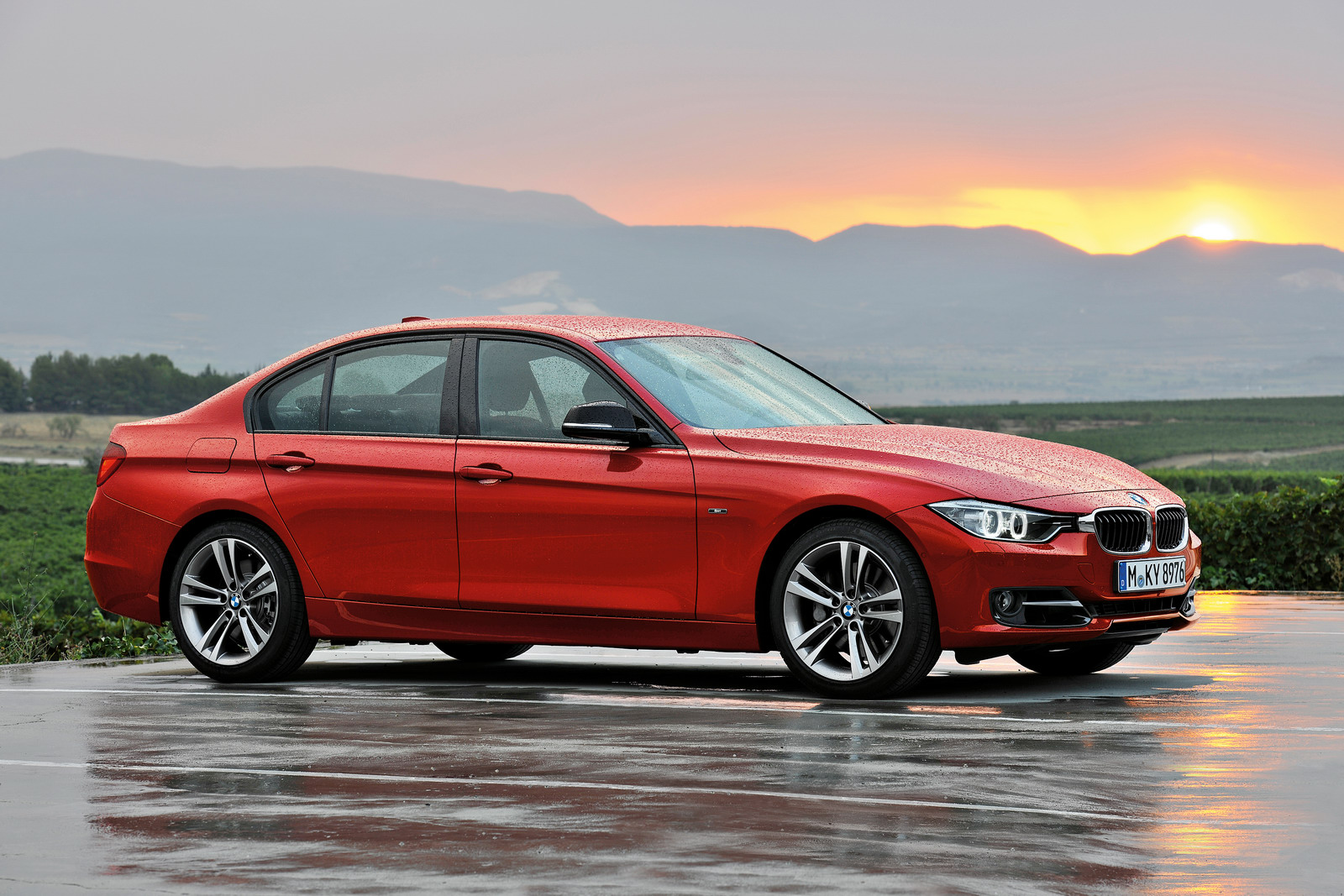
The F30 – The sixth generation
Introduced in 2012, the new F30 BMW 3 Series increased in length by 93mm compared to its predecessor and featured a stiffer body and all-new chassis based on a longer wheelbase, (2,810mm in length, an increase of 50mm on the previous model) and wider tracks (by 37mm at the front and 47mm at the rear). This provided clear advantages when it came to interior space. With 18mm more feet entry freedom, 15mm more knee room and 8mm more headroom in the rear, while the height of the rear door and its opening angle were increased to make entry and exit easier. None of this was at the expense of luggage space, which increased by 20 litres to 480 litres.
The new 3 Series Saloon was sporty and more elegant than its predecessor. Improved proportions, pronounced wheel arches, headlamp units which blended into the double-kidney grille to form a continuous band across the front of the car and air inlets beneath the headlights visually stretch the width and make the new 3 Series Saloon look low, wide and sporty.
The engine range for the sixth generation 3 Series had been further developed and now included a new four-cylinder 2.0-litre petrol unit, developing 245hp and 350Nm of torque, in the 328i. It replaced the six-cylinder 3.0-litre engines in the previous 325i and 330i, with inherent advantages for weight and fuel consumption, yet with a 0-62mph time of 5.9 seconds in manual form.
Efficiency was also significantly improved with both manual and automatic versions of the 328i achieving a fuel economy of more than 44mpg and CO2 emissions below 150g/km. The new unit featured High-Precision Direct Injection, BMW’s new TwinScroll turbocharging, Double-VANOS variable camshaft timing and VALVETRONIC variable valve opening technology.
Less than a month after launch, three further engines were added. The 316d and 318d diesels, powered respectively by 116hp and 143hp variants of the 2.0-litre diesel engine, plus another version of the 2.0-litre turbocharged petrol engine for the 320i.
The EfficientDynamics technologies which gave the previous BMW 3 Series Saloon such a competitive advantage remained very much in place, and were supplemented with new ones. Auto Stop-Start was fitted to all versions, manual and automatic, along with Brake Energy Regeneration, on-demand control of engine ancillary components and tyres with less rolling resistance.
Weight had also been reduced by up to 50kg compared with the previous model, while the drag coefficient (Cd) was down to as low as 0.26 thanks to optimised aerodynamics. The F30 featured a streamlined underside, covers which created a diffuser effect at the rear and Aero Curtain air channels in the front apron which reduced the turbulence created by the revolution of the front wheels in their arches.
For the first time, all versions of the sixth generation 3 Series Saloon and Touring models featured Drive Performance Control as standard – a switch which allows the driver to swap between up to four driving modes, varying from sporty to extremely economical. The four modes included ECO PRO, Comfort, Sport, and Sport +.
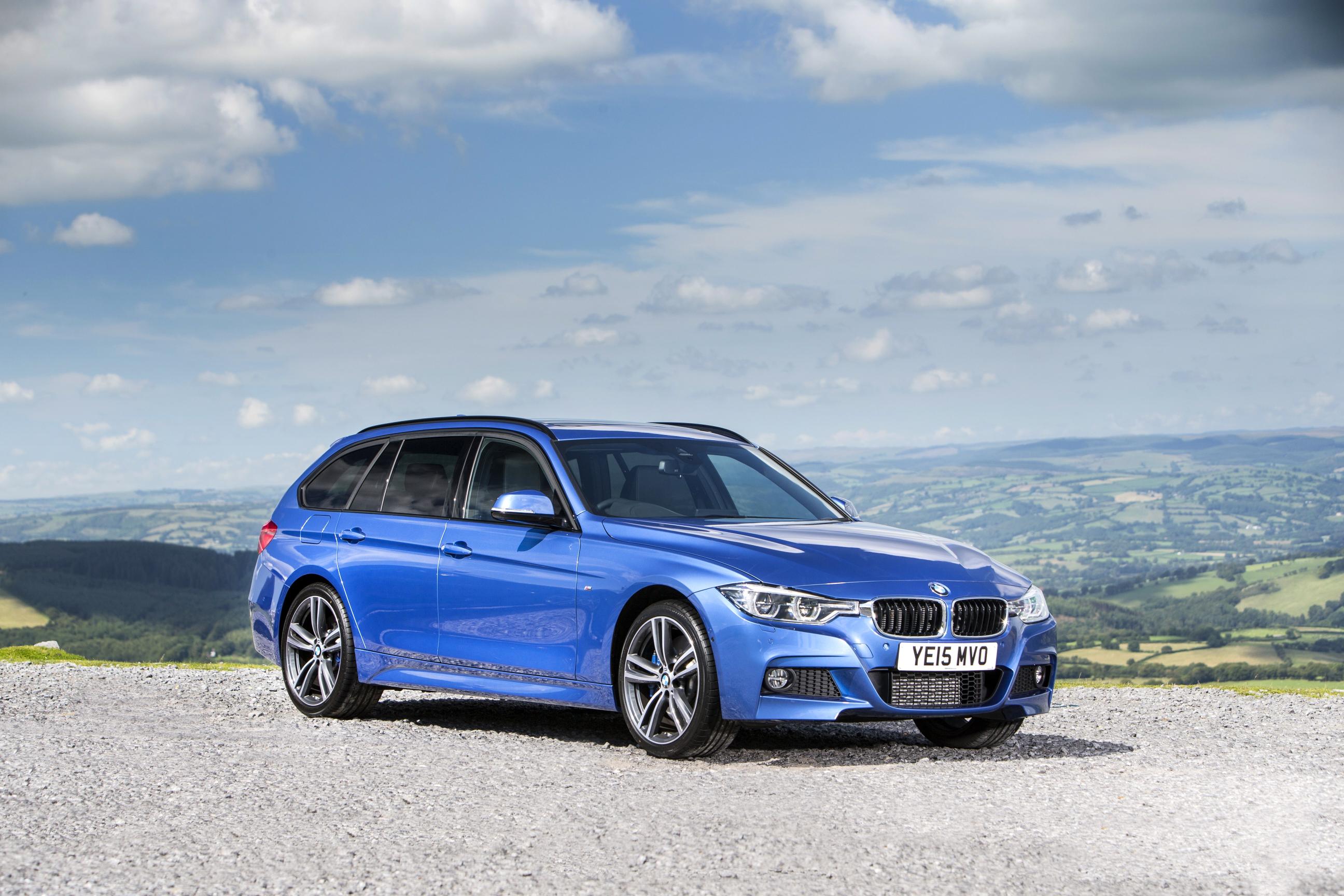
The new BMW 3 Series 2015
- Front and rear styling emphasised by new head- and tail-lights including optional full-LED headlights; new materials and highlights in the cabin
- New four- and six-cylinder petrol engines
- All petrol engines and 316d, 318d and 320d diesels sourced from the latest modular BMW EfficientDynamics engine family featuring BMW TwinPowerTurbo technology
- The new BMW 320d EfficientDynamics Plus achieves 72.4mpg with 99g/km
- Monthly cost to own an 320d EfficientDynamics Sport is just an additional £3 over the ED Plus (99g/km)
- Plug-in Hybrid 330e to join the range in 2016, with 252hp, 134.5mpg and 49g/km
The BMW 3 Series has been a sales phenomenon, with 14 million cars sold since production began with the E21 model in 1975. During that time the model has defined the premium sports saloon segment with today around a quarter of all BMWs sold coming from the 3 Series range.
The new 3 Series Saloon and Touring models receive a subtle evolution to their front and rear styling, with new materials and highlights introduced to the interior to even further boost the sporting yet comfortable ambience.
Under the bonnet, the majority of engines are completely new and hail from the latest modular BMW EfficientDynamics engine family, with standout models such as the new three-cylinder 318i, the 326hp 340i, the 99g/km 320dED and the 335d with 630Nm of torque. With further advancements to gearboxes, chassis dynamics and personalisation options, plus a huge array of advanced technology such as the new optional BMW Professional Navigation, the new BMW 3 Series is better equipped than ever before to continue the legend.
| Model | Price from |
Power Hp |
Torque Nm |
0 – 62mph Seconds |
Top Speed Mph |
Combined Mpg |
CO2 Emissions g/km |
| 318i | £24,975 | 136 | 220 | 8.9 (9.1) | 131 | 52.3 (54.3) | 124 (122) |
| 320i | £27,255 | 184 | 290 (270) | 7.2 (7.3) | 146 | 48.7 (51.4) | 134 (129) |
| 330i | £33,005 | 252 | 350 | 5.9 (5.8) | 155 | 43.5 (48.7) | 151 (136) |
| 340i | £32,805 | 326 | 450 | 5.2 (5.1) | 155 | 36.7 (41.5) | 179 (159) |
| 316d | £27,435 | 116 | 270 | 10.7 (10.6) | 127 | 68.9 | 109 |
| 318d | £28,685 | 150 | 320 | 8.6 (8.4) | 134 (132) | 67.3 | 111 |
| 320d ED | £30,485 | 163 | 400 | 7.9 (7.8) | 143 (140) | 72.4 (74.3) | 102 (99) |
| 320d | £29,785 | 190 | 400 | 7.3 (7.2) | 146 (143) | 67.3 | 111 |
| 330d | £37,615 | 258 | 560 | 5.6 | 155 | 56.5 | 131 |
| 335d | £40,330 | 313 | 630 | 4.8 | 155 | 51.4 | 145 |
Note: The figures above are for key Saloon models. Statistics for xDrive and Touring models vary slightly from those above.
Design and equipment: refining excellence
The new BMW 3 Series has a strikingly attractive presence on the road. The distinctively sculpted long bonnet and setback passenger compartment combine with short front and rear overhangs, and a long wheelbase, to create the familiar dynamic proportions of a BMW. In its own way, these are as much a hallmark of a BMW as the perfect 50:50 weight distribution.
Revised headlights include optional LED units with LED indicators now positioned as “eyebrows” above the headlights. These full-LED headlights, which are even more efficient than the xenon headlights offered to date, work with the optional BMW Selective Beam system. The camera-based, anti-dazzle High Beam Assistant adjusts the car’s lights using actuators to ensure the road is illuminated as well as possible without dazzling oncoming traffic and vehicles travelling ahead.
In addition, the “eyes” of the BMW 3 Series have moved further apart, visually strengthening the car’s broad stance on the road. In cars with standard specification lighting, the headlights are joined by two LED daytime driving light units on each side. These light strips highlight the hallmark BMW twin headlight arrangement and link the headlight units with the traditional BMW kidney grille.
At the front, broader side air intakes are integrated into the sculptural form of the bumpers. The new, more intricate structure of the central air intake also allows the radar sensor for the Active Cruise Control (ACC) to be housed more discreetly. At the rear, the new rear lights are full-LED units. The light bars, arranged in a distinctive BMW “L” shape, are more heavily curved, and the integrated LED brake lights now respond faster. The two-piece LED indicators form a horizontal band of light across both sections of the rear lights and stretch into the boot lid (or the tailgate on the BMW 3 Series Touring).
New exhaust tail pipes are fitted to different models depending upon engine output. The range-topping BMW 340i features individual 80mm tailpipes on the left and right, while the engines for the 320i and 320d models upwards now come with dual tailpipes, each 70mm in diameter. The tailpipe for the entry-level models measures 75mm in diameter. There is also a new range of wheels, with rims up to 19 inches in diameter available as an option, and 20-inch wheels can be selected from the Original BMW Accessories range.
High-quality interior: further refinements, superb ergonomics
The driver focus inside the new BMW 3 Series is a signature BMW feature and provides optimum access to all the important functions. The outstanding ergonomics of the BMW 3 Series have been improved further still and in addition, carefully arranged chrome highlights and high-gloss surfaces give the interior an even classier look.
For example, areas such as the central control panel in the centre console are finished in high-gloss black, while chrome accents feature on the new controls for the electric seat adjustment, the electric window controls and the air vents. In Luxury, Sport or M Sport models, the accent strip in the instrument panel continues into all four doors. Other new features include cup holders in the centre console with a sliding cover and an additional practical storage area for items such as a smartphone, positioned forward of the cup holders.
Different models enable further individualisation
Offered as an alternative to standard specification, the Sport and Luxury models place emphasis on different aspects of the new BMW 3 Series’ character. The M Sport model offers additional options designed to further increase road presence and driving enjoyment.
The Luxury and M Sport models can now also be specified as an option with the Ash Grain wood panel with metal inlay. Luxury models now come with the new bi-colour 18- inch light-alloy wheels in a multi-spoke design as standard. Among the features of the M Sport model are leather upholstery, the M aerodynamic package, an M leather steering wheel, M Sport suspension, front sports seats, the anthracite-coloured headliner and the Driving Experience Control switch with additional Sport+ mode.
Overall, customers can choose from a total of 16 exterior colours, with new additions to the range including Mediterranean Blue metallic, Platinum Silver metallic and Jatoba metallic in addition to the Individual colour Champagne Quartz metallic. The Estoril Blue metallic shade is still reserved exclusively for M Sport models.
The BMW M3 also gains the new full-LED rear lights and updates to the interior. The latest-generation Professional Navigation system with LTE – the fastest mobile standard currently available – is standard for this model, while two new BMW Individual exterior colour shades (Smoked Topaz metallic and Champagne Quartz metallic) are available in addition to the exclusive Tanzanite Blue metallic and Azurite metallic BMW Individual paint finishes.
Powertrain and chassis: new engines for unbeatable performance with efficiency
The new BMW 3 Series Saloon and Touring ranges feature a total of four petrol engines and seven diesel engines. All the three-, four- and six-cylinder petrol engines, and the four-cylinder diesel units in the BMW 316d, BMW 318d and BMW 320d, are now sourced from the newly developed, modular BMW EfficientDynamics engine family and are equipped with the latest BMW TwinPower Turbo technology, which combines exceptional performance with excellent fuel efficiency.
Engine technology: rapid responses and EU6-compliant.
All members of the new modular engine family share a common design blueprint, with an in-line cylinder arrangement, a displacement per cylinder of 500 cc and very lightweight, thermally optimised all-aluminium construction. The crankcase is very rigid due to its closed-deck design – which means that the cylinder water jacket is closed at the top – while thermally joined, high- strength cylinder liners with twin-wire, arc-sprayed coating save weight and reduce internal friction.
The three- and four-cylinder engines have balancer shafts for smooth performance throughout the engine speed range. Their modular design is also reflected in standardised interfaces for the engine mounts and the connections to the cooling system, intake and exhaust systems as well as the heating and air conditioning systems.
All the petrol engines in the new BMW 3 Series Saloon and Touring models feature an exhaust-manifold-integrated turbocharger. That means the exhaust gases have only a short distance to travel to the turbocharger system, resulting in very rapid responses to the throttle. On the BMW 320d, further improvements have been achieved by using anti- friction bearings instead of plain bearings. At the same time the system’s significantly reduced internal friction is beneficial even during the very short warm-up phase, resulting in substantially reduced cold-start fuel consumption. The close-coupled catalytic converter and the electrically operated boost pressure control valve (wastegate) further improve the emissions performance of the petrol engines.
All the engines in the new BMW EfficientDynamics engine family are equipped with the latest generation of BMW’s innovative TwinPower Turbo technology, which in the case of the petrol engines feature TwinScroll turbocharging, High Precision Injection and Double-VANOS variable camshaft timing, plus VALVETRONIC fully variable valve timing.
The BMW TwinPower Turbo technology for the diesel engines comprises VNT turbocharging and the latest-generation of common rail direct injection, which with maximum injection pressures of 2,000 bar helps reduce fuel consumption and emissions.
Four-cylinder performance: three-cylinder fuel consumption
The entry-level engine in the new BMW 3 Series Saloon and Touring ranges offers typically strong performance. The new BMW 318i, which replaces the previous BMW 316i, is the first BMW of this size to be fitted with the new three-cylinder petrol engine. Among the highlights of this engine are its compact dimensions and low weight, excellent performance and efficiency and typical three- cylinder qualities such as sharp responses, a willingness to rev and a sporty engine sound. A further advantage of the new three-cylinder engine is its good vibration characteristics: like a six-cylinder in-line engine, it generates no first- and second-order inertia forces. At the same time, a balancer shaft counteracts engine roll torque for impeccable refinement throughout the engine speed range.
This new engine delivers maximum power of 136hp from a displacement of just 1.5-litres and has a peak torque of 220 Nm. For short periods this can be increased to 230 Nm by using the overboost function that is activated by kickdown. With the six-speed manual gearbox, the BMW 318i accelerates from 0-62mph in just 8.9 seconds on the way to a top speed of 130mph. Despite this dynamic performance, however, the CO2emissions stand at just 122g/km (with eight-speed Steptronic transmission), a 12 per cent improvement over the previous BMW 316i. Fuel consumption is equally impressive, with the Saloon returning up to 54.3mpg and the Touring 51.4mpg.
Also making its debut in the new BMW 3 Series is a new 2.0-litre four-cylinder in-line engine available in two different states of tune. Fitted in the new BMW 320i Saloon and Touring models, it develops a maximum output of 184hp between and a maximum torque of 290 Nm with six-speed manual gearbox and rear-wheel drive. This is combined with CO2 emissions of up to134g/km and fuel consumption as low as 48.7mpg.
In the new BMW 330i, the successor to the previous BMW 328i, it generates 252hp and 350 Nm torque. This gives the new BMW 330i Saloon with eight- speed Steptronic transmission a 0–62mph sprint time of 5.8 seconds (Touring: 5.9 seconds) and a top speed of 155mph in both Saloon and Touring models. Nevertheless, the CO2 emissions of the BMW 330i Saloon has fallen compared with the previous model by 8 per cent to 136g/km, and the combined fuel consumption now stands at 48.7mpg.
Dynamic new six-cylinder petrol engine
The new BMW 3 Series also sees the world debut of the all-new six-cylinder engine from the latest modular BMW EfficientDynamics engine family. This new BMW 340i, available in Saloon and Touring variants, effectively replaces the previous 335i. It’s a light but rigid all-aluminium unit with BMW TwinPower Turbo technology, and with a displacement of three-litres, it develops a maximum power of 326hp, a 20hp improvement over the previous model. Peak torque is an impressive 450 Nm. The new BMW 340i Saloon with the standard-fit eight-speed Steptronic transmission goes from 0-62mph in just 5.1 seconds, with a governed top speed of 155mph. And although it offers significantly more power and superior torque up by 50 Nm compared to before, CO2 emissions are seven per cent down on the old 335i Saloon at 159g/km (Touring 164g/km). The combined fuel consumption is as low as 41.5mpg.
The diesel engines: strength with frugal fuel consumption
Big efficiency improvements have also been achieved on the optimised four-cylinder diesel units, which belong to the same new modular family as the petrol engines. The latest improvements are down to BMW TwinPower Turbo technology, with VNT turbocharging and high-pressure common rail direct injection. For example, the 116hp BMW 316d Saloon returns up to 68.9mpg, with CO2 emissions of only 109g/km.
The output of the new BMW 320d has risen beyond that of its predecessor model (up from 184hp to 190hp) and CO2 emissions have been reduced by 6 per cent. With its powerful torque of 400 Nm, the new BMW 320d Saloon with eight-speed Steptronic transmission returns a 0–62mph time of 7.2 seconds, two tenths of a second less than the previous BMW 320d Saloon. The new BMW 320d achieves a top speed of 143mph, but generates CO2 emissions of just 111g/km.
New manual and automatic transmissions
The new BMW 3 Series Saloon and new BMW 3 Series Touring can be fitted with a six-speed manual transmission or eight-speed Steptronic unit (standard on the BMW 330d, BMW 335d and BMW 340i Touring). The crisp-shifting six- speed manual transmission, featuring optimal ratio spacing, comes with a dual-mass flywheel with centrifugal pendulum absorbers. This technology, which made its world debut in a production-model 320d EfficientDynamics Edition, counteracts uneven running on high-torque engines so that drivers can change up smoothly and without any unpleasant booming noise even at low engine speeds – leading to a further reduction in fuel consumption and CO2 emissions. The six-speed manual transmission also comes with engagement speed control, which means the engine is automatically brought to the right rpm for the next gear when changing up or down.
The new eight-speed Steptronic transmission, like the six-speed unit, also plays an important part in reducing CO2 emissions. Its improved efficiency, wider gear spread and reduced torque converter slip during gearshifts reduce CO2 emissions by 3 per cent. At the same time, improved damping of engine irregularities makes for improved comfort and smoother shifting. In the Sport+ transmission mode, the software allows the driver to rev the engine right up to the rev limiter, and also to perform multiple sequential downshifts. For even greater control, the eight-speed Steptronic Sport transmission is available with steering wheel paddle shifters.
Further economy benefits are offered by the eight-speed Steptronic transmission’s coasting mode. When the driver lifts off the throttle at higher speeds, for example on a gentle downhill grade on the motorway, the engine is automatically decoupled from the powertrain. It then simply ticks over in neutral, which saves fuel and ensures there is no unwanted engine braking at high speed. An additional fuel-saving feature, which also improves driving comfort, is the new Proactive Driving Assistant, which uses information from the navigation system to “anticipate” upcoming roundabouts, corners and junctions and select exactly the right time to change gear.
xDrive: the Dynamic all-wheel drive system available as an option on many models
As an alternative to the classic BMW rear-wheel-drive set-up, the BMW 320i, 320d and 330d variants of the new BMW 3 Series model range can be ordered with BMW xDrive intelligent all-wheel drive. Thanks to its huge torque output, the BMW 335d is fitted with this technology as standard. BMW xDrive combines the customary advantages of all-wheel drive such as optimal power transfer to the road, excellent safety and maximum traction, with BMW’s typically agile and precise handling.
BMW 3 Series dynamics: typically agile yet comfortable suspension
The new BMW 3 Series Saloon and Touring models feature retuned – slightly stiffer – suspension and optimised steering that further improves their dynamic ability under all payload conditions. This includes new damper settings, new bump stops front and rear and thicker roll bars which all contribute to the reduced body roll, excellent directional stability and steering precision, whether with the standard setup, or the M Sport suspension and adaptive suspension alternatives. The latter offers electronically controlled dampers and allows individual adjustment of the car’s dynamic responses at the touch of a button. Continuous sensor monitoring of longitudinal and lateral acceleration, speed and steering angle allows the damping to be optimally matched to road characteristics and the driving situation. Rear-wheel-drive variants also feature a 10mm drop in ride height. Drivers can use the Driving Experience Control switch to choose between a more comfort-biased setting or more sporting characteristics at any time. In addition to this, changes have been made to the strut top mounts which now have five bolts instead of three, to spread load and increase performance while reducing bolt size so there’s no increase in weight. The thickness of the steel has also been increased from 1.6mm to 3mm for additional stiffness and to allow higher loads to be transmitted in sporty driving.
BMW EfficientDynamics: Superb performance, exceptionally low fuel consumption
The new BMW 3 Series Saloon and new BMW 3 Series Touring models combine their exciting performance with excellent fuel economy – a combination achieved with the help of the trailblazing BMW EfficientDynamics technologies. New, more fuel-efficient petrol and diesel engines are mated with further improved manual and automatic transmissions, Auto Start Stop, Brake Energy Regeneration, the ECO PRO mode and the on-demand operation of ancillary units. The latter includes the on-demand coolant pump, electronically controlled oil pump and electromechanical power steering that consumes no electrical power when steering straight ahead. Also, whenever the air conditioning is not being used, its compressor is automatically disconnected.
BMW 320d EfficientDynamics models: the clear efficiency leaders
The fuel-saving potential of BMW EfficientDynamics is reflected most clearly in the new BMW 320d EfficientDynamics Plus Saloon and Touring models, which offer up to 74.3mpg fuel consumption and CO2emissions as low as 99km. These models are powered by a modified 2.0-litre turbodiesel engine developing maximum power of 163hp and maximum torque of 400 Nm. They feature an optimised transmission configuration, modified gear shift indicator (on models with a six-speed manual transmission), low-rolling resistance tyres, a partially masked kidney grille and lowered ride height. The 320d EfficientDynamics Plus models also offer a high level of standard specification including Business Navigation, leather upholstery and heated seats.
The new BMW 320d ED Sport emits just 104g/km of CO2 (manual: 108g/km) , and has a combined fuel consumption of 70.6mpg, making it the cleanest and most fuel-efficient sports model in the 3 Series range. The improved technologies include a lowered suspension set-up, working to improve aerodynamics and overall performance and efficiency. This allows the 320d ED Sport Saloon to occupy a VED Band B and the Touring model to occupy the VED Band C with a Benefit in Kind (BIK) taxation rate of only 19 and 20 per cent respectively (Automatic: 19 and 20 per cent). Owners of the 320d ED Sport can also benefit from a low cost of ownership thanks to the £350 increase in residual value of the vehicle over the ED Plus. This allows customers to have the additional sporting styling and enhanced specification of the ED Sport for just £3 more than the cost of the ED Plus model.
The 330e: a Plug-in hybrid with CO2 emissions of just 49g/km
The new BMW 330e will offer a startling combined fuel consumption of 134.5mpg and CO2 emissions of 49g/km when it joins the range in 2016. Its state-of-the-art plug-in hybrid technology combines a 184hp 2.0-litre petrol engine with an 80 kW electric motor. The combined output of 264hp and combined maximum torque of 420 Nm (provisional figures) give the BMW 330e a 0-62mph acceleration time of just 6.3 seconds and a top speed of 140mph. This model is also capable of travelling up to approximately 22-miles in all-electric mode, and therefore emits zero local emissions when used in this manner.
BMW ConnectedDrive: Optimum connectivity and intelligent driver assistance systems.
With yet more new functions added to the unrivalled combination of mobility services and driver assistance systems, BMW ConnectedDrive is once again pioneering new technology to enhance safety, comfort and infotainment.
Business Navigation is now standard on all BMW 3 Series Saloon and Touring models.
The optional latest-generation Professional Navigation system boasts quicker start-up, even faster route calculation along with more realistic 3D visualisation in cities. The navigation system is also adaptive, so that when the driver deliberately deviates from a suggested route several times the system will start to propose the new “learned” route as the standard one for reaching the selected destination. Automatic map updating (which is free of charge for the first three years) and the ConnectedDrive Services enable individual regions of the navigation map to be updated wirelessly over the air by means of the vehicle’s integrated SIM card. This is carried out in the background while in the home region.
The new BMW 3 Series is also the first car in its segment to support LTE – the fastest mobile standard currently available – when fitted with the Professional Navigation system and the extended smartphone connectivity option. This greatly improves network coverage and data transmission speeds, especially in rural areas.
Intelligent Emergency Call, another standard feature in the BMW 3 Series, detects if the airbags are triggered in an accident, and then uses the built-in SIM card to automatically transmit the severity of the accident, the potential risk of injury to the occupants and the vehicle’s location to the BMW Call Centre. The manual emergency call function, meanwhile, allows rapid help to be summoned for other road users in emergency situations.
Head-Up Display: information in the driver’s immediate field of view
A full-colour, high-resolution Head-Up Display is available as an option. All relevant information, such as speed, navigation instructions, speed limits and overtaking bans, appears in an optimum position in the driver’s field of view. The safety information from the Driving Assistant package (Collision Warning with City Braking function, Pedestrian Warning with City Braking function, Attentiveness Assistant, plus Lane Departure Warning) as well as information relating to telephone and media operation is also shown in the Head-Up Display.
Parking Assistant for parallel and transverse parking
The Parking Assistant in the new BMW 3 Series helps the driver to park in both parallel spaces and spaces that are perpendicular to the road. At speeds below approximately 22mph, ultrasonic sensors measure potential parking spaces, which are then shown in the central information display. If the driver now activates the Parking Assistant, the car will steer itself into the space while the driver merely has to control the accelerator and brake or switch between forward and reverse gear when prompted. The Parking Assistant also includes the new Auto PDC function, which allows the Park Distance Control to switch on automatically when approaching an object at the front and display the remaining distance. When traffic jam situations with stop-start traffic are detected, the Auto PDC function is deactivated.
The new BMW 3 Series Saloon and Touring models is on sale from July 2015.

